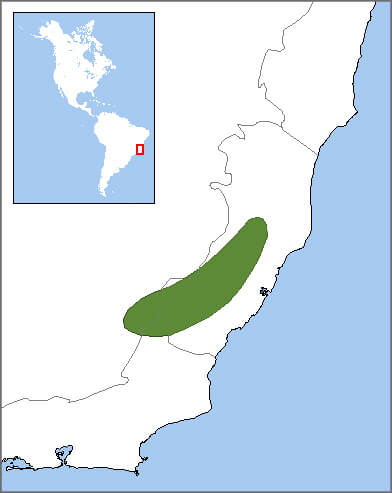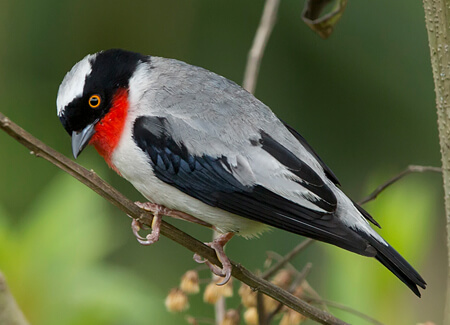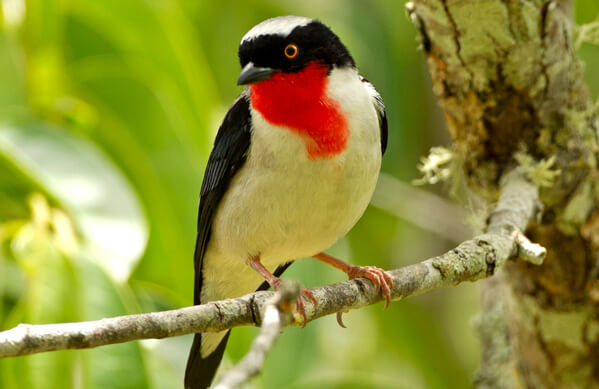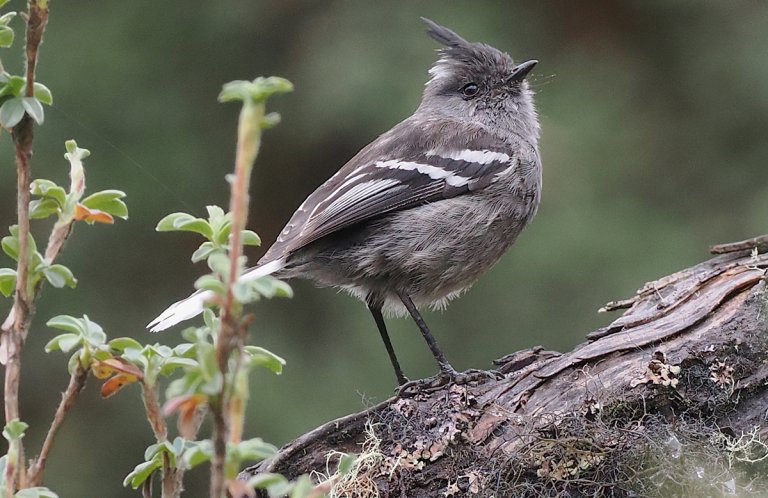
Cherry-throated Tanager range map by ABC.
The Cherry-throated Tanager is known as saira-apunhalada (“stabbed tanager") in Portuguese due to its vivid red throat. This species was first described in 1870 from a single specimen, not seen again until 1941, then rediscovered once more in 1998.
“When Brazilians talk about the five most threatened birds in the country, the Cherry-throated Tanager is one of them,” says Bennett Hennessey, Brazil Program Coordinator at ABC. “It is one of our emergency birds.” Habitat loss is the biggest threat to this and other Atlantic Forest species such as Golden-tailed Parrotlet.
Atlantic Forest Flocks
This species is a year-round resident of a small patch of Atlantic Forest habitat in southeast Brazil. The birds tend to forage at the top of the canopy, a habit that makes them difficult to spot. They are usually located by their loud, sharp call.
Sign up for ABC's eNews to learn how you can help protect birds
Traveling through the trees in pairs or small flocks of up to a dozen birds, Cherry-throated Tanagers forage for a variety of insects, spiders, and other small arthropods on moss- and lichen-covered branches. Like other tanagers, such as Seven-colored Tanager and Gilt-edged Tanager, the birds may join mixed-species feeding flocks.
Coinciding with a peak in food abundance and the change between dry and wet seasons, the Cherry-throated Tanager begins nesting in late November. Pairs are monogamous, remaining together for the breeding season.
The female builds a cup-shaped nest in a tree, where she incubates her clutch of two or three eggs. Both parents feed the young.
Saving Habitat to Save the Species
The Cherry-throated Tanager is listed as Critically Endangered on the IUCN Red List of Threatened Species. It's also a candidate for listing under the Alliance for Zero Extinction.
“We still know so little about this bird,” says Hennessey. “We don't know why it has declined so drastically, other than the typical habitat destruction” faced by so many birds of Brazil's Atlantic Forest.
 Our partner SAVE Brasil has been active in the region since 2005, and worked with Grupo Águia Branca—one of the country's largest transportation and logistics companies—to create this private reserve. SAVE Brasil has also been working with the state government to create a 10,625-acre wildlife refuge adjacent to the private reserve; ABC supported SAVE Brasil on the public consultation process in 2016. ABC and SAVE's support of the government on outreach for the wildlife refuge also helped in the creation of the private reserve. We hope that the creation of the private reserve will accelerate the process for the wildlife refuge.
Our partner SAVE Brasil has been active in the region since 2005, and worked with Grupo Águia Branca—one of the country's largest transportation and logistics companies—to create this private reserve. SAVE Brasil has also been working with the state government to create a 10,625-acre wildlife refuge adjacent to the private reserve; ABC supported SAVE Brasil on the public consultation process in 2016. ABC and SAVE's support of the government on outreach for the wildlife refuge also helped in the creation of the private reserve. We hope that the creation of the private reserve will accelerate the process for the wildlife refuge.
The surrounding Caetés region is important for five other globally threatened birds as well: White-necked Hawk, Brown-backed Parrotlet, Golden-tailed Parrotlet, Vinaceous Amazon Parrot, and Bare-throated Bellbird. Threatened mammals also occur in this region, including brown-throated sloth and the endangered buffy-headed marmoset.
Donate to support ABC's conservation mission!



















































